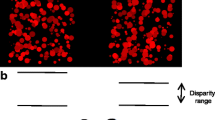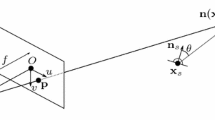Abstract
Grey-scale images consist of physical measurements of light. Scale-space theories have been developed to unconfound these measurements from the detector grid. In this framework, we look into the problem of binocular stereo. On a sufficiently large scale, a pixel carries information not only of the grey-value, but of the entire grey-value n-jet, i.e., derivatives up to order n. The subject of this paper is to show, in a general context, how the scale-space n-jet can be exploited for binocular matching. The analysis leads (under appropriate assumptions) to a direct determination of the local n-jet of the disparity field. The general result is an analysis which could be incorporated into many existing stereo algorithms to improve their use of the grey value data. In the computational scheme presented here, the estimations are strictly local, but based on image derivatives at a scale where the image structure is significant. This scale is automatically selected by minimising computational uncertainty. Results are shown as direct computations of surface normals on synthetic and real images.
Similar content being viewed by others
References
J. Arnspang, “Notes on local determination of smooth optic flow and the translational property of first order optic flow,” Technical Report 88–1, Institute of Datalogy, University of Copenhagen, Denmark, 1988.
J.L. Barron, D.J. Fleet, S.S. Beauchemin, and T.A. Burkitt, “Performance of optical flow techniques,” in IEEE Proceedings of Computer Vision and Pattern Recognition, 1992, pp. 236–242.
P. Belhumeur, “A binocular stereo algorithm for reconstructing sloping, creased, and broken surfaces, in the presence of halfocclusion,” in International Conf. on Computer Vision, Berlin, Germany, 1993.
J. Blom, B.M. ter Haar Romeny, A. Bel, and J.J. Koenderink, “Spatial derivatives and the propagation of noise in Gaussian scale-space,” J. of Vis. Comm. and Im. Repr., Vol. 4, No. 1, pp. 1–13, 1993.
G.C. DeAngelis, I. Ohzawa, and R.D. Freeman, ‘Depth is encoded in the visual cortex by a specialized receptive field structure’ Nature, Vol. 352, pp. 156–159, 1991.
Frédéric Devernay and Olivier Faugeras, “Computing differential properties of 3–D shapes from stereoscopic images without 3–D models,” Technical Report 2304, INRIA, Sophia Antipolis, France, 1994.
O. Faugeras, Three-Dimensional Computer Vision, MIT Press, 1994.
D.J. Fleet and A.D. Jepson, “Computation of component image velocity from local phase information,” International Journal of Computer Vision, Vol. 5, pp. 77–104, 1990.
L.M.J. Florack, “Grey-scale images,” Technical Report ERCIM-09/95–R039, INESC Aveiro, Portugal, Sept. 1995.
Luc Florack and Mads Nielsen, “The intrinsic structure of the optic flow field,” Technical Report 94–R033, ERCIM, 1994.
J. Fourier, The Analytical Theory of Heat, Dover Publications, Inc.: NewYork, 1955. Replication of the English translation that first appeared in 1878 with previous corrigenda incorporated into the text, by Alexander Freeman, M.A. Original work: “Théorie Analytique de la Chaleur,” Paris, 1822.
R.D. Freeman and I. Ohzawa, “On the neurophysiological organization of binocular vision,” Vision Research, Vol. 30, No. 11, pp. 1661–1676, 1990.
J. Gårding and T. Lindeberg, “Direct computation of shape cues by multi-scale retinotopic processing,” 1993, submitted.
Jonas Gårding and Tony Lindeberg, “Direct computation of shape cues based on scale-adapted spatial derivative operators,” International Journal of Computer Vision, 1995, to appear.
D. Geiger, B. Ladendorf, and A. Yuille, “Occlusions and binocular stereo,” in Proc. Europ. Conf. on Computer Vision,G. Sandini (Ed.), Santa Margherita Ligure, 1992, pp. 425–433.
W.E.L. Grimson, “From Images to Surfaces,” MIT Press: Cambridge, MA, 1981.
B. Horn and B. Schunck, “Determining optical flow,” Artificial Intelligence, Vol. 23, pp. 185–203, 1981.
G.J. Jones and J. Malik, “A computational framework for determining stereo correspondence from a set of linear spatial filters,” in Proceedings of the European Conference on Computer Vision, G. Sandini (Ed.), Santa Margherita Ligure, Italy, May 1992, pp. 395–410. Springer-Verlag.
J.J. Koenderink, “The structure of images,” Biol. Cybern., Vol. 50, pp. 363–370, 1984.
J.J. Koenderink, Solid Shape, MIT Press: Cambridge, MA, 1990.
J.J. Koenderink and A.J. van Doorn, “Invariant properties of the motion parallax field due to themovement of rigid bodies relative to an observer,” Optica Acta, Vol. 22, pp. 773–791, 1975.
J.J. Koenderink and A.J. van Doorn, “Receptive field families,” Biol. Cybern., Vol. 63, pp. 291–298, 1990.
T. Lindeberg, “Scale-space behaviour and invariance properties of differential singularities,” in Proc. of the NATO Advanced Research Workshop Shape in Picture-Mathematical Description of Shape in Greylevel Images, O. Ying-Lie, A. Toet, H.J.A.M. Heijmans, D.H. Foster, and P. Meer (Eds.), volume 126 of NATO ASI Series F, Springer Verlag, Berlin, 1994, pp. 591–600.
J. Milnor, Morse Theory, volume 51 of Annals of Mathematics Studies, Princeton University Press, 1963.
Mads Nielsen, “Scale-space generators and functionals,” Gaussian Scale-Space, Kluwer Academic Press, 1996, to appear.
Mads Nielsen and Rachid Deriche, “Binocular dense depth reconstruction using isotropy constraint,” in Theory & Applications of Image Processing II-Selected articles from the 9th Scandinavian Conference on Image Analysis, Gunilla Borgefors (Ed.), World Scientific Publishing, 1995.
I. Ohzawa, G.C. DeAngelis, and R.D. Freeman, “Stereoscopic depth discrimination in the visual cortex: Neurons ideally suited as disparity detectors,” Science, Vol. 249, pp. 1037–1041, Aug. 1990.
S.I. Olsen, “Stereo correspondence by surface reconstruction,” IEEE Trans. Pattern Analysis and Machine Intelligence, Vol. 12, No. 1, pp. 309–315, 1990.
M. Otte and H.H. Nagel, “Optical flow estimation: Advances and comparisons,” in Proc. Europ. Conf. on Computer Vision, J.-O. Eklundh (ed.), Stockholm, Sweden, 1994, pp. 51–60.
S.B. Pollard, J.E.W. Mayhew, and J.P. Frisby, “Pmf: A stereo correspondance algorithm using a disparity gradient constraint,” Perception, Vol. 14, pp. 449–470, 1985.
Marc Proesmans, Eric Pauwels, and Luc Van Gool, “Coupled geometry-driven diffusion equations for low level vision,” in Geometry-Driven Diffusion in Computer Vision, B.M. ter Haar Romeny (Ed.), Computational Imaging andVision, Kluwer Academic Publishers B.V., 1994, pp. 191–228.
M.R. Spiegel, Mathematical Handbook, Schaum' Outline Series, McGraw-Hill Book Company: New York, 1968.
Jon Sporring and Mads Nielsen, “Direct estimation of time to contact,” in Proc. 9th Scand. Conf. on Image Analysis, Uppsala, Sweden, 1995, pp. 941–948.
Massimo Tistarelli, “Computation of coherent optical flow by using multiple constraints,” in Proc. Intern. Conf. on Computer Vision, Boston, 1995, pp. 263–268.
J. Weber and J. Malik, “Robust computation of optical flow in a multi-scale differential framework,” IJCV, Vol. 14, No. 1, pp. 67–81, 1995.
P. Werkhoven, “Visual perception of successive order,” Ph.D. thesis, Utrecht University, University of Utrecht, Department of Physics of Man, Princetonplein 5, 3508 TA Utrecht, the Netherlands, May 1990.
A.P. Witkin, “Scale space filtering,” in Proc. International Joint Conference on Artificial Intelligence, Karlsruhe, Germany, 1983, pp. 1019–1023
Author information
Authors and Affiliations
Rights and permissions
About this article
Cite this article
Nielsen, M., Maas, R., Niessen, W.J. et al. Binocular Stereo from Grey-Scale Images. Journal of Mathematical Imaging and Vision 10, 103–122 (1999). https://doi.org/10.1023/A:1008330904886
Issue Date:
DOI: https://doi.org/10.1023/A:1008330904886




